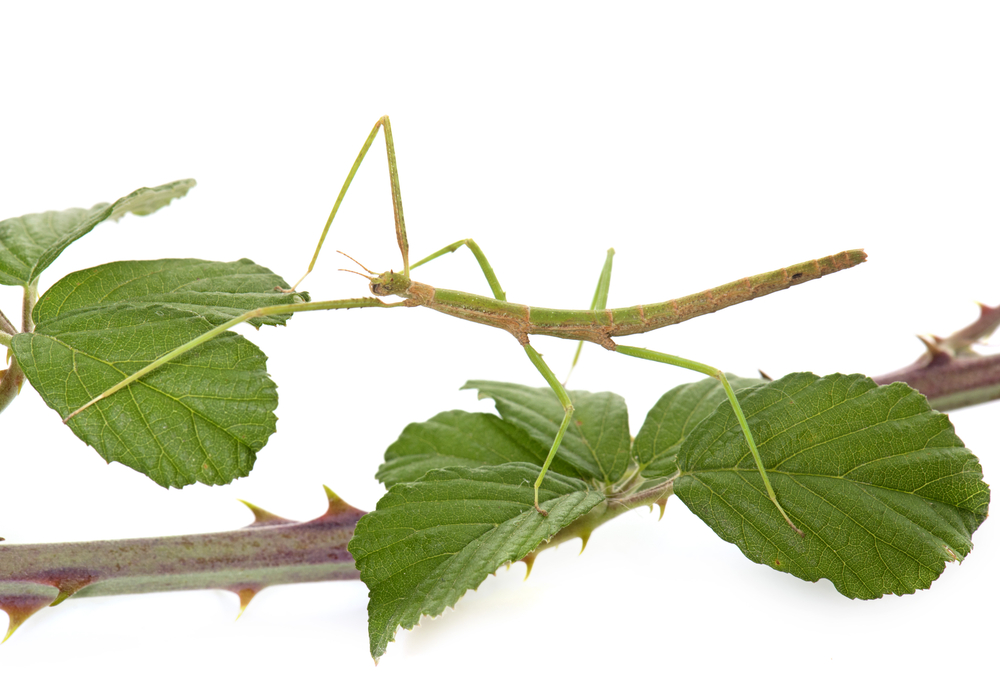Possibly the best species of pet insects are from the order Phasmatodea, also known as the stick insects. Stick insects are a large group of herbivorous insects with a nearly worldwide distribution, with most species being found in the tropics.
They breed quickly, are often quite large and tend to be slow-moving and peaceful, making them great pets for adults and children alike. Even though some species are poisonous if ingested or can pinch, none are venomous.
There are many interesting species in the hobby and most are very easy to keep once a few key requirements are met.
Though there are around 3000 species in the Phasmatodea only a handful of the larger species are regularly kept in captivity. Perhaps the most commonly kept species is the Indian stick insect, Carausius morosus, which reproduces rapidly and is commonly kept in schools, universities, and museums. Other popular species include the leaf insect, the giant prickly stick insect, and the jungle nymph.
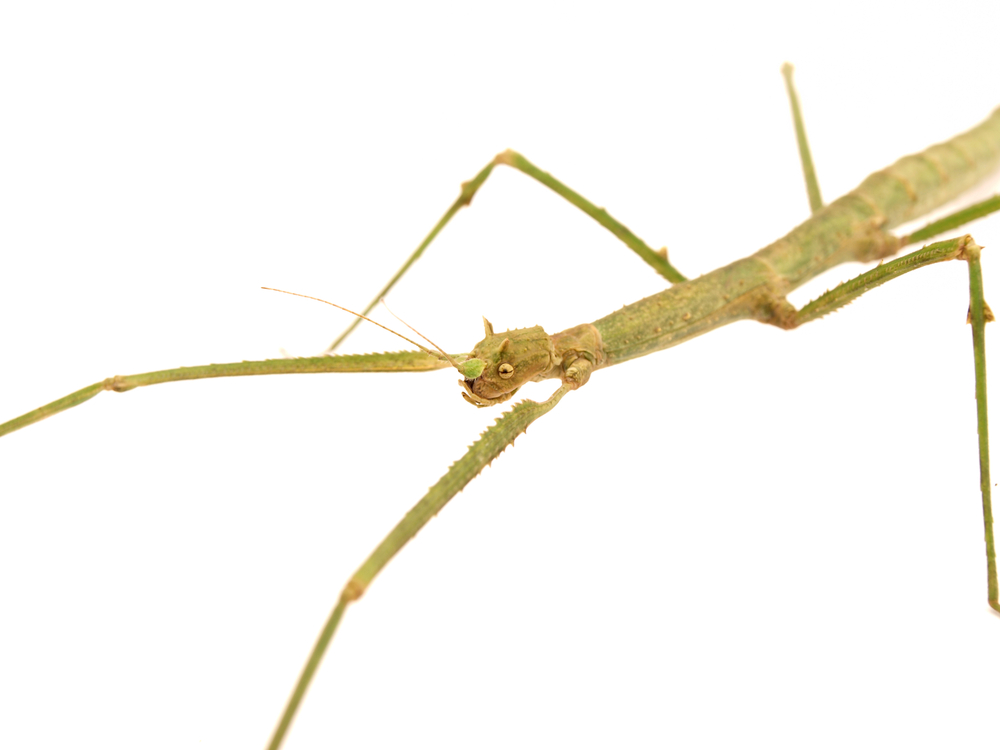
Stick insects in their natural environments are nocturnal and are found living on the plants that they eat. Each species of stick insect is selective about which plants they eat, though the Indian stick insect is fairly generalist in its diet and will feed on oak, blackberry, ivy, and a variety of others. Stick insects camouflage themselves, often mimicking the plants they live on, and spend most of the day completely still and feeding mainly at night. They display a wide variety of interesting behaviors, such as playing dead when startled or fanning their colorful wings in a spectacular warning display when startled. Some species of stick insect, the jungle nymph in particular, are well known for displaying aggression when not accustomed to human contact.
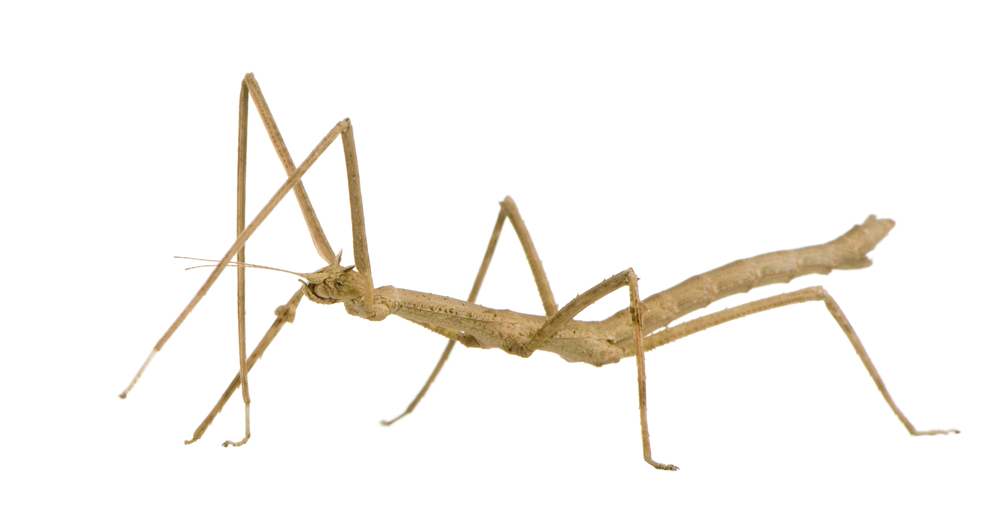
Enclosure
Stick insects need a tall enclosure in order to survive. Glass terrariums can work if they are of the right proportions, but mesh cages are often considered the best to allow the insects more space to climb. It is important to mist your stick insects and a mesh enclosure will make this a lot easier. The bottom of the enclosure should be covered with a substrate to regulate humidity and absorb frass (poop). Coconut coir, soil, or fine gravel all work well in this regard.
When selecting an enclosure height is probably the most important measurement to take into account. Molting is a dangerous time for stick insects and as such it is a good idea to make sure they have enough room to molt. Stick insects hang vertically to molt which is why at least the top of the enclosure should be made of mesh, as this will allow for more successful molts. A general rule of thumb is that stick insects need an empty space more than 2 times the length of their body to molt properly.
In nature stick insects would generally be found living on a suitable host plant and as such the enclosure of a stick insect should put the focus on the foliage. Because they rely so heavily on camouflage, stick insects will suffer from stress if they do not feel well-hidden. In order to feel well-hidden, stick insects need to remain on or near their host plant. This is why the enclosure should be filled with the host plant, either as cut branches in water or as a live plant.
Temperature
Different species of stick insect will have different temperature requirements based on their native environment. Many of the most attractive, large, and popular stick insects kept in captivity come from tropical environments and will need a temperature to match. Heat can be supplied with heating cables, pads, or light bulbs. It is important that, if a heat lamp is used, the insects cannot directly reach the lamp as the heat can cause burns.
Small temperature fluctuations between night and day are likely beneficial for your stick insects, as it mimics the natural conditions in which they would live. It is important, however, to avoid large changes in temperature. Freezing temperatures are fatal, as is extreme heat. If there is a power outage during cold weather you can wrap the enclosure in insulating material to prevent heat loss. You can protect your pets from excess heat with misting, which will lower the temperature in the enclosure via evaporative cooling.
Humidity & Ventilation
When keeping arthropods in general humidity is often the most troubling issue. Different species of insects have very different humidity requirements, and if these requirements are not met the result can be fatal for the insect. Molting issues are often caused by humidity that is too low, and excessively high humidity without proper ventilation can lead to molding and fungal infection.
There are several ways to keep the humidity in your stick insect enclosure at optimum levels. The first is to mist. Misting is very important for your stick insects, as aside from the plants they eat your pets will rely heavily on mist droplets as a source of water. You should mist stick insects at least once per day, possibly more when molting. If you keep live plants in the enclosure, as opposed to branches in water, it is a good idea to place a dish of water filled with stones on the bottom of the enclosure. This will stabilize humidity levels and potentially provide a source of drinking water, though not all stick insects will use it. You can keep track of the humidity of your stick insect enclosure with an electronic humidity monitor.
Diet
Perhaps the most important part of stick insect care is getting their diet right. Stick insects are herbivorous and each species will often be limited to just a handful of host plants. This is why it is absolutely vital that you know which species of stick insect you have and what plants the insect can eat. A stick insect given the wrong food will not eat and thus starve to death.
To care for your stick insects, you will need to provide them a constant supply of fresh greenery of the correct species. Many of the common pet stick insects feed on ivy, privet, bramble, rose, oak, and hawthorn leaves. You can find these plants growing in parks, public places, and maybe even in your own backyard. If your desired species of stick insect is a specialist on a plant not found in your area, you will have to grow it yourself. You will need to regularly pick branches of the plant, which you can set in water like you would a bouquet of roses. You can keep these branches fresh for several days to a week before they will begin to wilt. Stick insects will not feed on wilted or dead leaves. If you keep your plants in a cup of water, it is very important that you cover the surface of the water to prevent drowning.
Depending on the stick insect species it is also possible to grow the plant in a pot and keep the pot inside the enclosure. This way the plant will never wilt or dry out but will need regular care. Depending on how many stick insects you wish to keep it might also be a good idea to grow several plants that you can rotate, which will allow the plant to recover from feeding from your pets.
Tankmates
Stick insects are generally best kept either alone or with their own species in breeding colonies. They are fragile insects and can be easily injured by other tankmates. You cannot keep stick insects with any kind of vertebrate, due to their size and their potential to cause physical damage. Perhaps the only suitable roommates for stick insects would be small organisms used as terrarium janitors. Springtails and isopods work very well in this regard, as they are very peaceful and will not harm your stick insects. Certain kinds of small cockroaches, particularly those that do not climb, can also live comfortably in the substrate alongside a stick insect colony.
Tank Maintenance
You should plan on regularly cleaning your stick insect enclosure. Stick insects produce a lot of frass, which can mold and cause health issues for your pets. Frass should be removed once a week and dirty substrate either replaced or cleaned. It is also important to replace dry, dead, and wilted branches and leaves with fresh ones so that your pets have a constant food source.
In recent years, tank cleaning arthropods have become popular. Most popular are isopods and springtails, though millipedes, beetles, and some others have been used as well. These organisms are peaceful and will not harm your pets and do generally do a good job of cleaning up waste, though they do not remove the need for regular tank cleaning.
Handling
Though they are usually very peaceful creatures, it is best to avoid handling your pet stick insects whenever possible. This is because stick insects are extremely fragile and it is easy for them lose limbs. If you must handle your stick insects, it is best to slowly nudge them onto your hands or, if the individual is large, gently grasp them by the midsection. When moving your stick insects, try to move slowly to avoid falls. If you wish to handle your stick insect regularly you should keep larger, more robust species that take handling better.
Some stick insects will display aggressive behaviors when they are annoyed or startled. Some will use the joints on their legs to pinch, while others will release noxious smelling liquid or display colorful warning signals. Some can even spray nasty acidic fluid at attackers. Many have spines and thorns on their body to stop would-be predators. These species, despite their fearsome defenses, are generally harmless to humans and can do no more than cause a pinch or create a foul odor.
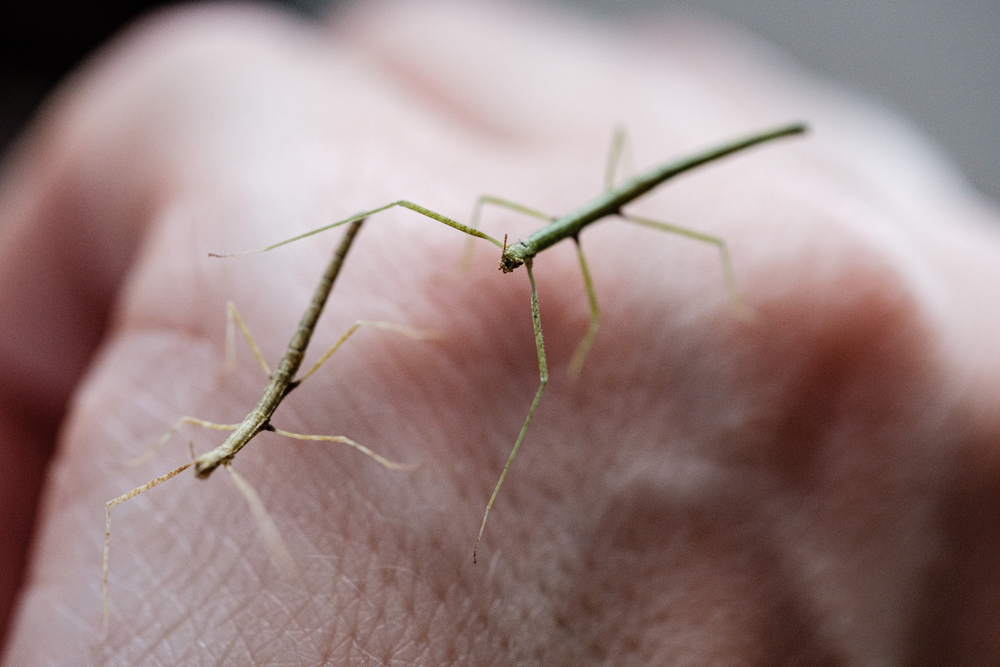
Health and Disease
The greatest threat to the health of your stick insects is molting. Most stick insects will molt several times throughout their lives and as such it is of critical importance to create conditions that foster successful molting. An improperly sized enclosure, humidity that is too low, or low temperature can interfere with molting and cause death. Pieces of exoskeleton that do not detach cleanly during molting can cause infection and make future molts more difficult, as well. If you notice that your stick insect is taking a very long time to molt or if your stick insect is not able to cleanly separate itself from its exoskeleton you should likely be increasing the humidity of the enclosure more and you can try to remove pieces of exoskeleton that do not come off cleanly during the molt.
Humidity that is too high, however, can have negative effects on insect health. In particular, when high humidity is combined with poor ventilation fungus can gain a foothold. Though most types of fungus are harmless, certain kinds can cause serious fungal disease in stick insects. Fungal infections are almost always fatal, which is why tank cleaning is so necessary. If you find that one of your stick insects has a fungal infection, keep it in quarantine away from the rest of your stick insects. Increase ventilation and lower the humidity, unless of course individuals are molting.
Another common problem with stick insects is their physical frailty. It is very easy for stick insects to lose limbs, be it from trauma or during a bad molt. The good news is that stick insects are very resilient to this kind of damage. If your stick insect loses a limb or antenna they should be able to regenerate the missing part during subsequent molts.
Pesticides can be a serious issue when keeping stick insects. Because stick insects feed only on living plant material, many stick insect owners collect host plant branches from parks and public places. These places may have been treated insecticides to kill plant pests or mosquitoes, which will also kill stick insects. There is no way to treat pesticide poisoning, which is almost always fatal, and as such it is important to make sure all food you give to your pets has not been treated with any insecticides or herbicides. If your city sprays for mosquitoes, do not collect plant material from your garden on spray days.
If you are able to avoid these health obstacles you can expect most stick insects kept as pets to live for at least a couple years, much of which is the growth of the insect from nymph to adult. A general rule of thumb is that larger stick insects tend to live longer, though there are exceptions. Females often live longer than males, sometimes years longer.
Breeding
Many species of stick insects are extremely easy to breed. When given the proper humidity, temperature, and access to the right food stick insects will breed freely, laying single hard eggs that resemble seeds. They will either flick these eggs down onto the substrate or place them on leaves and branches. Stick insects generally do not cannibalize their young or eggs and all life stages can be kept together.
As if breeding stick insects could not get any easier, there are many species of stick insect that are parthenogenic, which means they can reproduce without sex. These are the easiest species of stick insect to breed, as even a single individual can quickly reproduce itself into a large colony.
Stick insect eggs can take a very long time to hatch, sometimes even a few months, and when they do hatch the nymphs are very small. The care of nymphs is fairly simple, however, as they require conditions similar to the adults. Small nymphs will dry out quickly and as such proper humidity needs to be maintained with regular misting. It is quite easy for stick insect nymphs to drown and as such any water in the enclosure should be filled with pebbles. Very small nymphs may have trouble feeding on undamaged foliage, so keeping them with adults allows them to feed on leaves already damaged by the feeding of adults.
Because some stick insects can breed so rapidly it is a good idea to have a method to dispose of unwanted offspring. Do not ever release stick insects into the environment, regardless of where you are located. Stick insects can become serious pests in the right conditions. Instead, you should keep an insectivorous animal that can consume excess insects. You can also sell or give away your extras. If you can locate eggs that you do not want, you can freeze them to stop them from hatching.
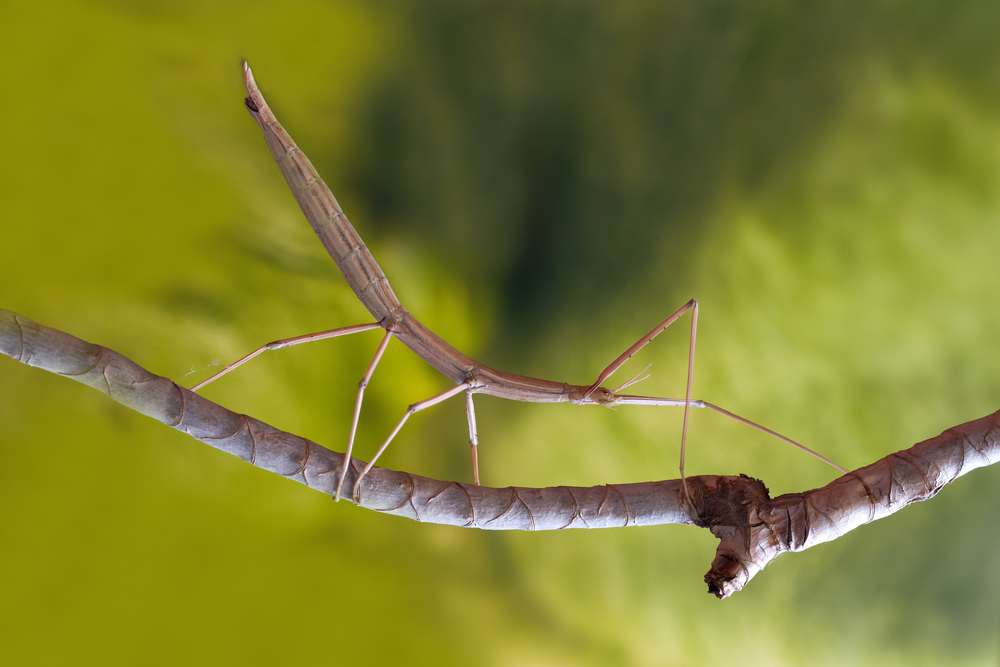
Legality
Some species of stick insects have the potential to become invasive in the right climates. This is because they can breed very quickly, with many species even being able to lay eggs asexually and can feed on economically important plants. Because of this, stick insects are illegal to keep in many countries. In the US, all non-native stick insects are illegal to keep in captivity without special permits unless they are already present in your region as an invasive species. Do not purchase stick insect eggs or nymphs unless you are absolutely sure that species is legal for you to keep, as keeping illegal species can result in large fines.
